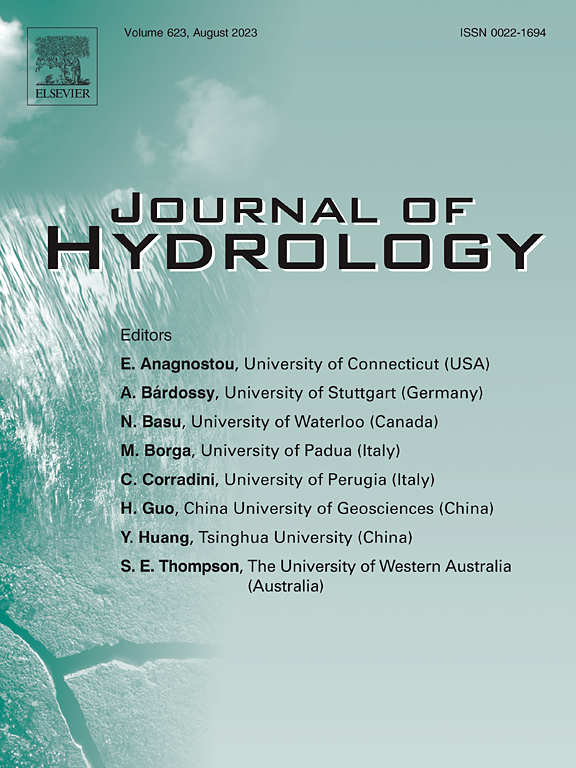Quantitative assessment and analysis of the impact of inter-basin water transfer on regional water resource stress
IF 6.3
1区 地球科学
Q1 ENGINEERING, CIVIL
引用次数: 0
Abstract
With the increasingly serious water shortage and other problems, Inter-basin water transfer (IBWT) has become an important measure to alleviate regional water stress. In this study, based on the improved water stress index (WSI), we comprehensively assessed the multi-scale (urban, tertiary basin zones) spatio-temporal status of WSI in the four major basins of the Huang, Huai, Hai and Yangtze River Basins (HHHYRB) from 1965 to 2020, and analysed the contribution of Inter-basin water transfer to alleviate regional water stress. The Dagum Gini coefficient method was used to determine the differences and sources of WSI distribution. Finally, the impact of each water transfer project was quantitatively analysed through bottom-up scenario derivation. The results show that 35.8% of the cities in the HHHYRB, and 40.4% of the tertiary basins are at medium or higher risk of water stress. The impacts of external inter-basin water transfers in the HHHYRB are all less than 0.002. The IBWT effectively mitigated the WSI in the Hai River Basin (75%) and the Huaihe River Basin (15.6%), negatively affected the WSI in the Yellow River Basin (−6.4%), and had only a 2% impact on the Yangtze River Basin. There is obvious spatial heterogeneity in the WSI of the HHHYRB, and the coefficients between groups (48.3%–66%) are higher than the coefficients within groups (17.3%–23.7%) and hypervariable density coefficients (10.8%–31%). IBWT projects effectively moderate the degree of inequality in water resources, with intra-basin impacts ranging from 1.77% to 33.69% and inter-basin impacts reaching 2.29%–7.28%. Most of the IBWT projects tend to transfer water from areas with low WSI to areas with high WSI with positive impacts, but there are still 10 water transfer projects with negative impacts. Therefore, the impacts of IBWT should be considered comprehensively when formulating water resources management policies in order to achieve long-term sustainable use of water resources.
流域间调水对区域水资源压力影响的定量评价与分析
随着水资源短缺等问题的日益严重,跨流域调水已成为缓解区域水资源压力的重要措施。基于改进的水资源压力指数(WSI),综合评价了1965 - 2020年黄淮海长江四大流域(HHHYRB)多尺度(城市、三级流域带)水资源压力指数的时空状况,并分析了流域间调水对缓解区域水资源压力的贡献。采用Dagum基尼系数法确定WSI分布的差异及其来源。最后,通过自下而上的情景推导,定量分析了各调水项目的影响。研究结果表明:三峡库区35.8%的城市和40.4%的第三系盆地处于中高水胁迫风险;外部流域间调水对三峡库区的影响均小于0.002。IBWT有效缓解了海河流域(75%)和淮河流域(15.6%)的WSI,对黄河流域(- 6.4%)的WSI产生了负面影响,对长江流域的WSI影响仅为2%。HHHYRB WSI存在明显的空间异质性,组间系数(48.3% ~ 66%)高于组内系数(17.3% ~ 23.7%)和高变密度系数(10.8% ~ 31%)。IBWT项目有效调节了水资源不平等程度,流域内影响范围为1.77% ~ 33.69%,流域间影响范围为2.29% ~ 7.28%。大多数IBWT项目都倾向于从低WSI地区向高WSI地区调水,并具有正向影响,但仍有10个项目具有负向影响。因此,在制定水资源管理政策时,应综合考虑IBWT的影响,以实现水资源的长期可持续利用。
本文章由计算机程序翻译,如有差异,请以英文原文为准。
求助全文
约1分钟内获得全文
求助全文
来源期刊

Journal of Hydrology
地学-地球科学综合
CiteScore
11.00
自引率
12.50%
发文量
1309
审稿时长
7.5 months
期刊介绍:
The Journal of Hydrology publishes original research papers and comprehensive reviews in all the subfields of the hydrological sciences including water based management and policy issues that impact on economics and society. These comprise, but are not limited to the physical, chemical, biogeochemical, stochastic and systems aspects of surface and groundwater hydrology, hydrometeorology and hydrogeology. Relevant topics incorporating the insights and methodologies of disciplines such as climatology, water resource systems, hydraulics, agrohydrology, geomorphology, soil science, instrumentation and remote sensing, civil and environmental engineering are included. Social science perspectives on hydrological problems such as resource and ecological economics, environmental sociology, psychology and behavioural science, management and policy analysis are also invited. Multi-and interdisciplinary analyses of hydrological problems are within scope. The science published in the Journal of Hydrology is relevant to catchment scales rather than exclusively to a local scale or site.
 求助内容:
求助内容: 应助结果提醒方式:
应助结果提醒方式:


